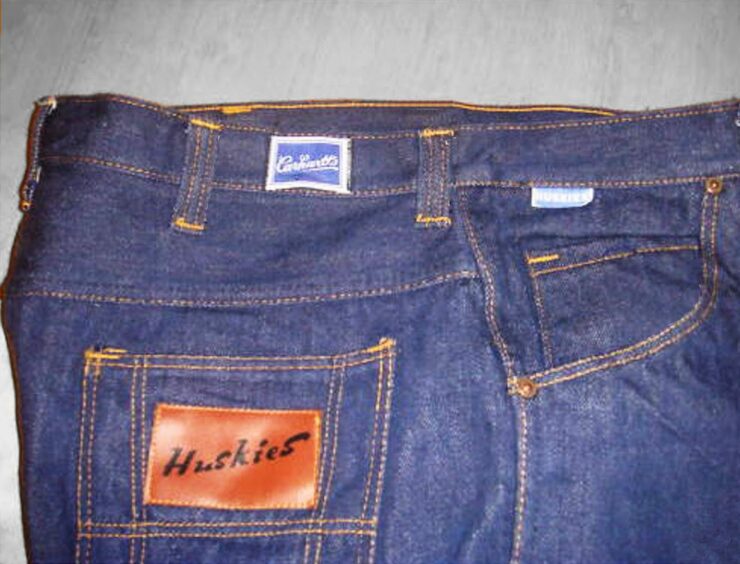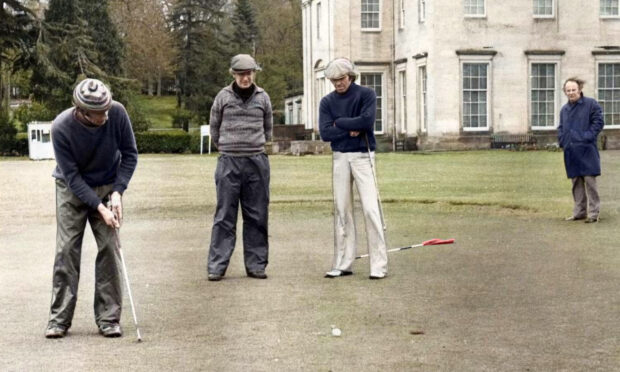
Forget the Wild West, Dundee was where everyone was decked out in denim when blue jeans became a must-have fashion item in the 1970s.
Created to give 1800s California mine workers some sturdy workwear, and beloved by cowboys and cowgirls too, American blue jeans grew and grew in popularity.
They became a wardrobe staple, and arguably took a quantum leap, when sported by James Dean in 1955’s Rebel Without A Cause.
So, the American teenager had arrived, the denim fashion spread and Dundonians were not slow in catching on.
Some of the best boutiques when denim ruled were the Great American Panthouse, Mr Beaujangles, Catchhand, Stable, Wildcat, Van Allan and Boy Meets Girl, which was Dundee’s first unisex boutique — with go-go dancers as an “added attraction”.
Changed days.
For men, bold shirts in conflicting colour schemes with enormous collars, flared trousers and platform shoes could be found in many wardrobes in the 1970s.
Let’s face it, it wasn’t an era characterised by its style, elegance or minimalism.
As well as flares, trends for women included pantsuits with silk bow blouses and blazers, while thighs were on display with hot pants which were known as ‘Daisy Dukes’.
Jeans with wider legs than waists
The Great American Panthouse in the Overgate offered “a galaxy of jeans for guys and gals” during the era of cheesecloth shirts and jeans with wider legs than waists.
It was complemented by Mr Beaujangles boutique, with its ever-present pounding beat music, which opened in November 1973 and closely followed the styles in London.
Mr Beaujangles was the brainchild of Dundee businessman Ian Dand and targeted the 16 to 25 age group with Radio 1 DJ Stuart Henry performing the opening ceremony.
The trend lighting and décor was complemented by go-go dancers at the weekend and the boutique was soon followed by shops in Aberdeen, Edinburgh and Kirkcaldy.
The demand quickly outweighed supply.
A female clothing section cornered the unisex market in Scotland and two more shops were added to the Dundee collection in the Wellgate Centre and Commercial Street.
In 1977 a jumpsuit would cost you £12.95 with men’s velvet jackets going for £31.95.
Mr Beaujangles was wound up and closed its doors in April 1982 in the middle of a television sales drive featuring Dundee United and Scotland footballer Paul Sturrock.
Sturrock appeared on TV promoting a free pair of trousers with every jacket bought.
The character with the Stetson who clothed a generation of teenagers bowed out, although the Mr Beaujangles name and logo lived on at the Overgate until the 1990s.
What about elsewhere?
Catchhand in Kirk Style sold Wrangler waistcoats and jackets and was doing a roaring trade with certain urban types who liked to be seen wearing Ben Sherman shirts.
The Catchhand tagline was: Casualwear with a ‘with it’ air.
In 1977 they were offering £3 off pairs of Brutus and Jet jeans — remember them?
The Stable boutique in Commercial Street was selling “lush velvet jackets, sensational jeans and fabulous shirts” for guys who were “really into what’s first-rate fashion”.
Wildcat Jeans made their own denim products at the Carolina Port factory, which were sold at their shops in the Overgate and the Murraygate — for men, women and children.
The glass-fronted Van Allan store in the Overgate stocked unisex ranges for men and women and in 1974 a belted jacket would cost £3.95 with flared trousers at £2.95.
Bang for your buck.
Boy Meets Girl in the Overgate was Dundee’s first attempt at selling gents’ and ladies’ clothing from the same shop and it was hugely popular despite being short-lived.
The unisex boutique also had the best shopfront logo in town.
The Retro Dundee blogger – who wishes only to be known as GG – knew all these shops well and he stitched together a potted history of denim from his days growing up in the city in the 1970s and 1980s.
He told me: “In the early to mid-1970s there was a certain amount of streetwise kudos to be had depending on the make of jeans you wore.
“Levi’s and Wrangler were the top two to be seen in.
“Anything less and you were a pauper!
“This kind of high and mighty street cred attitude waned from the mid-1970s when top-quality alternatives hit the scene by the likes of Brutus, Lee-Cooper, Wildcat, Pepe and Carhartt.
“There was pretty much denim everything — jeans, jackets, overcoats, waistcoats, shirts, belts, skirts, shoes, bags, hats, wallets, purses and wrist-watch bands.
“I even had a denim guitar strap!
“There were also a few phases denim wearers went through when they invented various ways to customise their jeans and jackets — including bleaching and cloth patches.
“When denim first began its 1970s domination the material was as stiff as cardboard, which meant you had to wash and sometimes sand down the jeans to make them comfy.
“Fashion brands, however, often took their cue from youth culture and eventually shops started selling pre-washed and stone-washed denim that were already softened.
“Even bleached jeans went on sale — same too with patched jeans.
“Kids were setting trends as opposed to being fashion victims.”
One by one the Dundee shops were shuttered up in the 1980s and 1990s.
GG said: “By the time the 1980s arrived, denim’s heyday had gone, however, and again in tandem with music influences, the youth’s dress sense changed with it.
“There was new wave, futurist, post-punk, new romantics, hip-hop, basically, the many various alternative music scenes, that had everyone wearing just about anything other than denim.
“There was one exception, however, when the new wave of British heavy metal scene surfaced in 1979/1980, a new generation of heavy-metal heads continued to clad themselves out in all denim, so denim never entirely disappeared from sight.
“By the mid-1980s onward, denim gear had started to be used by top designers as luxury items at hefty prices.
“Stars, celebs and yuppies would be seen wearing their Armani, Balmain and Versace expensive denim status symbols.
“That set a new standard, and ironically, the streetwise kids who earned kudos in previous years in Dundee, were now the paupers in comparison.”
Denim days in Dundee – million pairs of jeans a week
Dundee also had the Levi Strauss factory and the Carhartt factory which specialised in denim workwear but they too soon got involved in more trendy gear for teenagers.
US-based Hamilton Carhartt Workwear Ltd, was brought to Dundee in the early 1940s, and made overalls and workwear and the Huskie-brand jeans.
At its peak the company employed 800 people and had factories at Carolina Port and Baldovie in the city, as well as a shop in Murraygate, before collapsing in 1980.
From its ashes emerged a new Hamilton Carhartt company, which began manufacturing at Angus Works in North Isla Street and by 1990 the workforce swelled to around 100.
But a combination of factors hit the company hard and the business went into decline.
At its height, nearly 700 people worked at the city’s famous Levi’s factory in Kilspindie Road, where a million pairs of jeans were said to be leaving the plant every week.
But fortunes waned and, with the advent of globalisation, the product could be made cheaper elsewhere, so the factory wound down after 30 years and closed in 2002.
Gone but not forgotten.
Today, however, it’s easy to recreate your own 1970s denim fashion moment with the abundance of vintage and retro pieces available online at places like eBay and Vinted.
Look hard enough and you might even find a pair of Dundee Wildcat jeans.



















Conversation